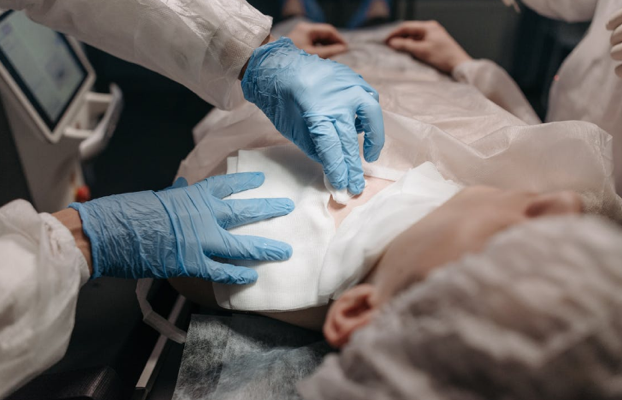Deep vein thrombosis or DVT is a severe venous condition caused due to blood clotting. The blood may clot due to a wide range of problems deep inside the body. A blood clot is a solid clump of blood, blocking the vein. Blood clots or blockage in veins can cause many serious conditions. Usually, deep vein clots develop in the lower leg or thigh. But, they might develop in other body parts as well. Furthermore, blood clots can also travel from one body part to another through veins. Some conditions associated with blood clots are:
- Postphlebitic syndrome
- Post-thrombotic syndrome
- Thromboembolism

Causes of Deep Vein Thrombosis
The major cause of deep vein thrombosis is blood clotting in the vein. When the clot blocks a vein, it disrupts the blood circulation process. As a result, various body parts may not receive proper blood supply. You might develop clotting for many reasons. Some common reasons are:
· Injury
An injury can cause damage to a blood vessel wall. This blocks and narrows the vein preventing blood flow. A blood clot may result in deep vein thrombosis.
· Surgery
During surgery, damage to the blood vessel can cause blood clotting. Also, less bed movement after surgery can cause blood clotting.
· Inactivity and Reduced Mobility
When you sit for extended hours without moving your body, you may develop a blood clot in the legs. The blood flowing from legs to heart requires pressure in the valve. When you move the valves start moving. However, when you sit at a place for a long period the blood moves backward due to gravity. This causes blood clotting.
· Certain Medications
The various medication increases the risks of blood clotting.
Diagnosis for Deep Vein Thrombosis
During diagnosis, the doctor will ask questions for other symptoms. They will identify the actual cause of blood clotting. Also, they will conduct a physical examination. They will check for skin discoloration, tenderness, and swelling. The test will help doctors identify the risk factors. They will understand whether you are at high or low risk of the condition. The tests include:
- D-dimer blood test helps to identify the condition’s severity.
- Duplex ultrasound generates images of blood clotting.
- Venography is rarely performed.
- A magnetic resonance imaging scan helps diagnose abdomen veins.
Treatment of Deep Vein Thrombosis
Deep vein thrombosis is a serious condition. If you identify the symptoms of this condition, you need to immediately consult a vein specialist. A healthcare provider will diagnose you for the condition and recommend an effective treatment. The treatment prevents blood clotting from growing. Furthermore, the treatment reduces the risks of pulmonary embolism. Furthermore, the treatment eliminates blood clotting. Here is some treatment plan the professional vein specialists will recommend:
1. Medication
When you visit a vein specialist, they will diagnose your condition and prescribe blood thinners. Blood-thinning medications reduce the risks of developing a blood clot. Furthermore, it also decreases the size of an existing blood clot. Also, the risk of developing more clots decreases after consuming these drugs. If blood thinners are ineffective, the doctor might recommend thrombolytic drugs. People with severe DVT conditions can also consume this medication. When the doctor injects a thrombolytic drug inside the vein, it breaks the existing clots.
2. Surgery
The doctor might also recommend surgery to remove DVT clots from the body. Usually, the doctor considers surgery for large blood clots or for blood clots that requires serious attention such as tissue damage.
During a surgical thrombectomy, a professional surgeon will eliminate the blood clot through a tiny incision in the vessel. They will identify the exact location of the clot through venous ultrasound. Once identified, they will remove the clot. After the surgery, the doctor repairs tissues and blood vessels.

In some conditions, the surgeon will keep the blood vessel open with the help of inflating the balloon. They will remove the clots while keeping the vessel open. Once they remove the clots, they will remove the balloon and seal the vein.
The surgery involves fewer risks those other invasive treatments. The risk factors include:
- Excessive bleeding
- Infection
- Damage to the blood vessel
Conclusion
Deep vein thrombosis is a severe condition but it can be treated through less invasive treatment methods. The surgeon will recommend various treatment procedures according to the severity. They will use various diagnostic procedures to identify the severity. Effective treatment procedures involve medication and surgery.
If you experience DVT symptoms, you can consult a professional vein specialist in your neighborhood. If you live in New York, you can contact the Vascular Surgery and Vein Center. At the Vascular Surgery and Vein Center, we have a professional vein specialist and surgeon, Dr. Norman Chideckel. He will diagnose your DVT condition and recommend the best treatment.
Vascular Surgery & Vein Center
108 East 96th Street
Front 1
New York, NY 10128
212-993-6133

